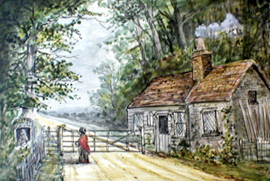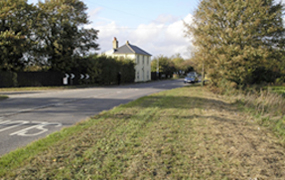Turnpike Gate Keeper 1776-1849
Whilst browsing through the Burial Records I came across John Coburn, Turnpike Gate Keeper who was buried on 30th November 1849. I wondered whether he was employed by the Cambridge-Godmanchester Turnpike which began at the bottom of Castle Hill (a marker stone is set in the wall of Kettle’s Yard Gallery) and followed the course of what is now Huntingdon Road and the A14.

Whittlesford turnpike gate c. 1835.
Watercolour by George Maynard
of Whittlesford. Cambridgeshire Archive

Dernford Turnpike Cottage 2009
Checking the census records showed that in 1841 he had in fact been working as a toll collector on the Cambridge-Great Chesterford Turnpike. Then aged 65, he was living with his wife Elizabeth and two of his children at the Dernford Turnpike Gate. A cottage still exists on this site just over the river/disused railway bridge as you leave Stapleford towards Sawston.
Turnpike Trusts were first set up in the early 18th century to take over responsibility for the main roads from local Parishes. Increased goods and passenger traffic were causing the roads to deteriorate and the Parishes could no longer meet their obligation to keep them in good repair. Local trustees took on this responsibility and were granted the right to collect tolls to cover their costs. By the end of the century Trusts were the accepted means of caring for main roads.
In the early 19th century, road surfaces were improving and travel times for stagecoaches were falling – only six hours from London to Cambridge! – and the latest coaches were able to carry eight passengers inside with a further eight outside. A variety of routes were taken but those coming through Great Chesterford, then an important coaching stop, would have paid their toll at the Dernford Gate, quite possibly to John Coburn. More local traffic could have originated at the nearby oil, flour and paper mills as well as the tanneries in Sawston. Local agricultural traffic would have been particularly busy on Market Days in Cambridge and Saffron Walden as livestock and produce were taken for sale. The period from 1800 to 1840 saw the Toll Road system at its most successful.
The arrival of the Railways in the 1840s ended the steady increase in road traffic so the Turnpike Trusts were unable to meet their costs. Gradually they were amalgamated and taken over by new highway authorities who in turn became the responsibility of local councils.
By 1849 John Coburn was living in George Street, Cambridge. He died, age 78, in November of that year and is buried with his wife in a grave with no memorial in area D.
Sources:
Bryan Howe at Sawston Village History Society. Sawston 150 years ago as remembered by G Challis ed. B Howe. Victorian Cambridge – Josiah Chater Diaries – Enid Porter, 1975
